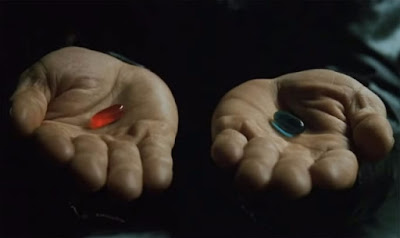We are so far down the wrong rabbit hole here, people
There's something gravely amiss with, and missing from, a post-Enlightenment society that elevates rich, charismatic, unempathic and sometimes sociopathic, narcissists to positions of power in society, even though that might risk a fall into a rigid, divisive, violent and authoritarian regime. This often employs viral iconography and near-deification of a supposedly 4D-chess-playing pseudo-messianic cult figure come to save us all – or at least come to save the Real Patriots or True Believers who surround the leader and form a protective thought-bubble around the beloved leader, insulating him or her and themselves from a more objective and realistic reality. What makes matters worse is that this movement is feeding into religious narratives such as the fight between good and evil during these Christian End Times – at the very time that benevolent communion with traditional establishments such as the Church is most needed. And what makes matters far worse is that such leaders find themselves advised by people who really want to “bring it on!”: not only keyboard warriors but self-appointed and zealous Agents of Chaos, sometimes backed by adversarial foreign states. This, on top of the influence the latter or the leader's regime have on compromised public figures.
Post-Trust in traditional figures and pillars of the Establishment has given rise to populism, often resorting to simplistic but emotive and attractive solutions to the many fears and complex crises we face; to arguments against those who warn of such crises, and denial that these crises exist – or indeed promoting and reliant upon ever-more elaborate and far-fetched conspiracy theories attached like a bed of limpets, or leeches, to some basic truth about which many could agree, such as cases of deceit perhaps in science, and even widespread corruption in business and politics.
This has given rise to an era of post-Truth and its alternative facts, and has led to post-Rationality, post-Chivalry and post-Honour, where rather than resign (or in earlier times fallen on their sword), the accused or disgraced go into a state of denial and even double down on their rigid stance, buoyed-up by legions of fanatics who would earnestly believe and willingly swear that black is white, that wrong is right, and down is up – a situation that is exacerbated by hate speech masquerading as free speech in the popular social media, at a time when traditional news media are struggling and also facing much opposition (the mainstream media being called-out for either right-wing or left-wing bias, and being labelled by some on the right as “enemies of the people”). Truth itself has become so fragmented and abused (as also have latter-day audiences), that in many instances it is virtually impossible for the average and even intelligent citizen to navigate the resultant mess, to decide what is true and what is false, or even tell truth from parody and fact from fiction, or fact and fiction from a blend we might term faction. Faction is all the more alluring for having a degree of truth at its core, surrounded by layers of glittering and enticing illusion, and very often playing on age-old or primitive, black-and-white modes of perception, and deep societal division, at the expense of rationality and nuance, and on instincts such as a need for certainty and security, feelings of alienation and abandonment, hope, fear, betrayal, resentment, and anger.
When it comes to a solution to this current set of problems, I personally don't have five major bullet points that I could offer you. What I can do, however, is point you to a number of other contemporary writers and thinkers whose work I've been studying over the years, and leave it to you to follow the breadcrumbs:
Re-enchantment in a Material World / the Battle for the Soul of the World
Image
Image 1: Hope in a Prison of Despair / Evelyn De Morgan (1855–1919) / Wikimedia Commons / Public domain.
Image description: Allegorical, pre-Raphaelite painting showing Hope as a woman or very young man holding a lamp, entering the dungeon where Despair is shown as another human figure bowed down with grief. Hope's saint-like halo suggests the comfort brought by religious faith.
Image 2: Morpheus offering Neo a choice of red pill or blue pill, in the film The Matrix. Source: YouTube.

